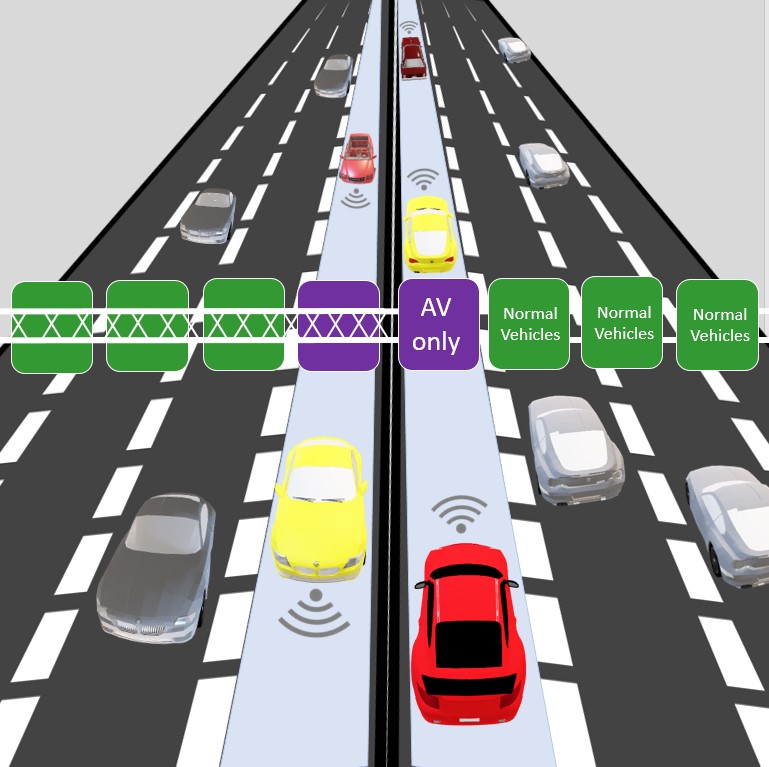
Abstract
The main objective of this research is to evaluate the safety impact of an innovative infrastructure solution for safe and efficient integration of Automated Vehicle (AV) as an emerging technology into an existing transportation system. Filling the gap in the limited research on the effect of AV technology on infrastructure standards, this project will evaluate whether AVs could operate safely in a narrow lane next to regular traffic lanes on an expressway. Specifically, this study will investigate implications of adding a narrow reversible AV exclusive lane to the existing configuration of I-15 expressway in San Diego, resulting in a 9-feet AV reversible lane, and in both directions, two 12-feet lanes for HOV and FasTrak vehicles. Given the difference between the operation of AVs and human-driven vehicles and reliance of AVs on sensors as opposed to human capabilities, the question is can we provide narrower roadways with more efficient right of ways assuming AVs are more precise in lateral and longitudinal lane keeping behavior? To accomplish the goal of the project, the research team will conduct a series of research approaches including literature review, AV manufacturers product review, expert interviews, consumer questionnaire review, crash data analysis, and traffic simulation analysis. We will prepare practical recommendations and guidelines from the results of the study usable for practitioners and professional organizations pertaining to AV development.
Project Highlights
- Evaluated implications of an innovative infrastructure solution, AV-exclusive lanes, for integration of AVs into an existing transportation system.
- Conducted expert interviews and investigated consumers’ opinions by reviewing NHTSA’s Vehicle Owner Questionnaires database.
- Examined a real-world case study of the I-15 expressway in San Diego by investigating crash data and simulating a narrow reversible AV-exclusive lane on its existing configuration.
- Developed recommendations for practitioners and professional organizations involved or interested in AV development.
Final Report
EWD & T2 Products
Course Module: module summarizing problem characteristics, research approach, and findings of the study
Poster presentation: presented at SDSU Student Research Symposium (SRS) by student Anagha Katthe.
Student Impact Statement – Anagha Katthe, Mahdie Hasani, Benjamin Melendez, Jackie Cacciarelli (pdf): The student(s) working on this project provided an impact statement describing what the project allowed them to learn/do/practice and how it benefited their education.
SDSU Student Research Symposium (SRS), Event Location: SDSU Campus, Event Date: Feb 2020, Title of the Poster Presentation: “Safety Impact Evaluation an Automated Vehicle Exclusive Lane on I-15; Crash Data Analysis”, Number of Attendees: Around 200 attendees, Project Personnel Involved: Anagha Katthe, Sahar Ghanipoor Machiani, & Arash Jahangiri.
Presentations/Publications
Ghanipoor Machiani, S., A. Ahmadi, W. Musial, A. Katthe, B. Melendez, & A. Jahangiri. (2021). “Implications of a Narrow Automated Vehicle Exclusive Lane on Interstate 15 Express Lanes.” Journal of Advanced Transportation, Special Issue on “Traffic Safety in Intelligent and Connected Environment.” https://www.hindawi.com/journals/jat/2021/6617205/
Melendez, B., A. Katthe, A. Jahangiri, S. Ghanipoor Machiani, A. Ahmadi, & W. Musial. (2021). “Safety Impact Evaluation of Narrow AV-Exclusive Lanes on Existing Freeways.” The 100th Annual Meeting of the Transportation Research Board & Record, Washington, DC.
Melendez, B., Anagha Katthe, Arash Jahangiri, Ghanipoor Machiani, S., Alidad Ahmadi, & Walter Musial. (2020). Safety Impact Evaluation of Narrow AV-Exclusive Lanes on Existing Freeways. Transportation Research Record: Journal of the Transportation Research Board.
Katthe, A., S. Ghanipoor Machiani, & A. Jahangiri. (2020, Feb 28). Safety Impact Evaluation an Automated Vehicle Exclusive Lane on I-15; Crash Data Analysis. Presented at SDSU Student Research Symposium (SRS).
Final Dataset
The data used in this study are publicly available at the https://www.nhtsa.gov/recalls and https://tims.berkeley.edu/help/SWITRS.php
Research Investigators (PI*)
Sahar Machiani (SDSU))*
Arash Jahangiri (SDSU)
Walter Musial (LLG Engineers)
Shankar Ramakrishnan (LLG Engineers)
Alidad Ahmadi (LLG Engineers)
Sam Amen (Caltrans)
Project Information
Start Date: 2019-04-01
End Date: 2020-09-30
Status: Complete
Grant Number: 69A3551747115
Total Funding: $228,504
Source Organization: Safe-D National UTC
Project Number: 04-101
Safe-D Theme Areas
Safe-D Application Areas
Operations and Design
Risk Assessment
Planning for Safety
Infrastructure Technology
More Information
Sponsor Organization
Office of the Assistant Secretary for Research and Technology
University Transportation Centers Program
Department of Transportation
Washington, DC 20590 United States
Performing Organization
San Diego State University
5500 Campanile Dr
San Diego, CA 92182
USA
